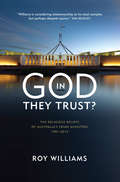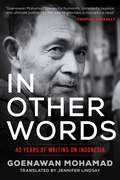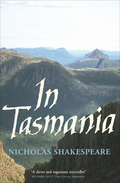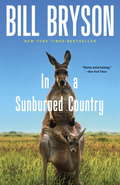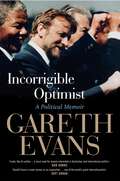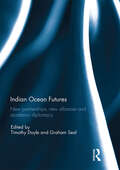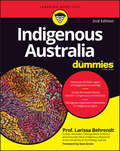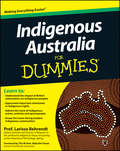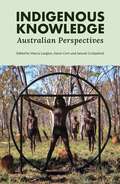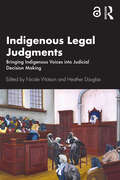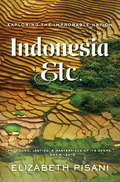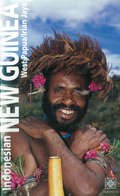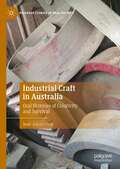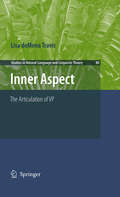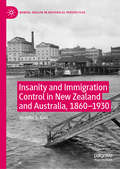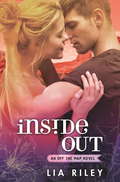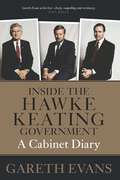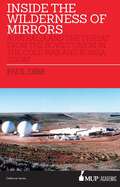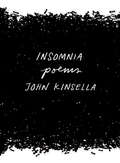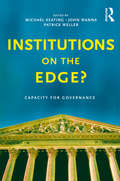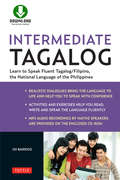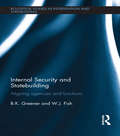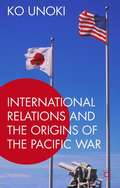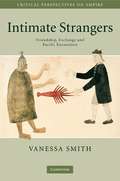- Table View
- List View
In God They Trust?: The Religious Beliefs of Australia's Prime Ministers 1901-2013
by Roy WilliamsMost of Australia's leaders since Federation believed in God. Some were serious Christians and very few were indifferent towards religion. In this timely and original book, Roy Williams examines the spiritual life of each of our Prime Ministers from Edmund Barton to Julia Gillard. He explores the ways in which - for good and ill - their beliefs (or agnosticism) shaped the history and development of the nation. Featuring extensive interviews with John Howard and Kevin Rudd, and pulling no punches, IN GOD THEY TRUST? will appeal to voters across party lines and excite plenty of debate among believers and non-believers alike.
In Other Words: 40 Years of Writing on Indonesia
by Goenawan MohamadA wide-ranging and beautiful collection of essays from one of world literature’s most important writers.Goenawan Mohamad is one of Indonesia’s foremost public intellectuals, and this translated volume of essays-spanning from 1968 to the present day-demonstrates the breadth of his perceptive and elegant commentary on literature, faith, mythology, politics, and history.Through the worst days of Indonesia's authoritarianism, in the face of the trauma of great violence and the chaos of democratic transition, Goenawan has never lost faith in the act of writing. Many of his essays from In Other Words were first published for Tempo, the Indonesian weekly magazine that he founded in 1971. His writings bring nuance and sympathy to difficult histories, introduce doubt to damaging certainties, and apply clarity of thought and action to times of great upheaval. Activist, journalist, editor, essayist, poet, commentator, theater director, and playwright, Goenawan Mohamad brings an unparalleled and wide-ranging perspective to the world. These essays, translated by his long-time collaborator Jennifer Lindsay, reveal a vision both uniquely Indonesian and completely universal, and indisputably establish him as one of the leading political thinkers and cultural observers in the world today.
In Tasmania
by Nicholas ShakespeareFrom the renowned British author of The Dancer Upstairs comes this &“meticulous, lyrical history&” of the remote island and his family&’s connection to it (Publishers Weekly). Hailed by the Wall Street Journal as &“one of the best English novelists of our time,&” Nicholas Shakespeare decided to move to Tasmania after falling in love with its exceptional beauty. Only later did he discover a cache of letters that revealed a deep and complicated family connection to the island. They were written by an ancestor as corrupt as he was colorful: Anthony Fenn Kemp (1773–1868), the so-called Father of Tasmania. Then Shakespeare discovered more unknown Tasmanian relations: A pair of spinsters who had never left their farm except once, in 1947, to buy shoes. Their journal recounted a saga beginning in Northern England in the 1890s with a dashing but profligate ancestor who ended his life in the Tasmanian bush. In this fascinating history of two turbulent centuries in an apparently idyllic place, Shakespeare weaves the history of the island with multiple narratives, a cast of unlikely characters from Errol Flynn to the King of Iceland, a village full of Chatwins, and a family of Shakespeares. &“Tasmania is an enigmatic place and Shakespeare captures it with an appreciative eye.&” —The Guardian
In a Sunburned Country
by Bill BrysonA CLASSIC FROM THE NEW YORK TIMES BESTSELLING AUTHOR OF ONE SUMMER Every time Bill Bryson walks out the door, memorable travel literature threatens to break out. His previous excursion along the Appalachian Trail resulted in the sublime national bestseller A Walk in the Woods. In A Sunburned Country is his report on what he found in an entirely different place: Australia, the country that doubles as a continent, and a place with the friendliest inhabitants, the hottest, driest weather, and the most peculiar and lethal wildlife to be found on the planet. The result is a deliciously funny, fact-filled, and adventurous performance by a writer who combines humor, wonder, and unflagging curiousity.Despite the fact that Australia harbors more things that can kill you in extremely nasty ways than anywhere else, including sharks, crocodiles, snakes, even riptides and deserts, Bill Bryson adores the place, and he takes his readers on a rollicking ride far beyond that beaten tourist path. Wherever he goes he finds Australians who are cheerful, extroverted, and unfailingly obliging, and these beaming products of land with clean, safe cities, cold beer, and constant sunshine fill the pages of this wonderful book. Australia is an immense and fortunate land, and it has found in Bill Bryson its perfect guide.From the Trade Paperback edition.
Incorrigible Optimist: A Political Memoir
by Gareth EvansA colourful and central figure in Australian politics for two decades—described by Bob Hawke as having 'the most acute mind' of any of his ministers—Gareth Evans has also been applauded worldwide for his contributions, both as Foreign Minister and in later international roles, to conflict resolution, genocide prevention and curbing weapons of mass destruction.In this sometimes moving, often entertaining, and always lucid memoir Evans looks back over the highs and lows of his public life as a student activist, civil libertarian, law reformer, industry minister, international policymaker, educator and politician. He explains why it is that, despite multiple disappointments, he continues to believe that a safer, saner and more decent world is achievable, and why, for all its frustrations, politics remains an indispensable profession not only for megalomaniacs but idealists.
Indian Ocean Futures: New Partnerships, New Alliances, and Academic Diplomacy
by Graham Seal Timothy DoyleIndian Ocean studies, which once lagged behind studies of the Atlantic and the Pacific, is an important emerging academic field which has come into its own. In the next fifty years, the Indian Ocean Region will become very significant as a result of enormous demographic changes. What was the Ocean of the South is rapidly becoming the Ocean of the Centre, the Ocean of the Future. Curtin University, Western Australia, has a long and distinguished history of engagement with the Indian Ocean region and with Indian Ocean Studies, and its Australia-Asia-Pacific Institute of Curtin University continues to maintain a focus on the Indian Ocean -past, present and future. This book examines a number of themes emerging from its 2014 Conference entitled "Indian Ocean Futures", which attracted some of the best Indian Ocean region scholars. The conference connected humanities, social sciences and scientific disciplines; this book collects some of the preeminent works focused on geo-strategic, cultural, environmental security and human security themes. The book is also an important contribution to the building of academic diplomacy in the region – that is to say, it contributes to region-building by creating epistemic communities and networks between government, the private sector, and academia throughout the region. Through the pursuit of academic diplomacy, academics are capable of pursuing research goals which enhance governmental, business, and civil society objectives of the day. This book was previously published as a special issue of the Journal of the Indian Ocean Region.
Indigenous Australia For Dummies (For Dummies Ser.)
by Larissa BehrendtA comprehensive, relevant, and accessible look at all aspects of Indigenous Australian history and culture What is The Dreaming? How many different Indigenous tribes and languages once existed in Australia? What is the purpose of a corroboree? What effect do the events of the past have on Indigenous peoples today? Indigenous Australia For Dummies, Second Edition answers these questions and countless others about the oldest race on Earth. It explores Indigenous life in Australia before 1770, the impact of white settlement, the ongoing struggle by Aboriginal and Torres Strait Islander peoples to secure their human rights and equal treatment under the law, and much more. Celebrating the contributions of Indigenous people to contemporary Australian culture, the book explores Indigenous art, music, dance, literature, film, sport, and spirituality. It discusses the concept of modern Indigenous identity and examines the ongoing challenges facing Indigenous communities today, from health and housing to employment and education, land rights, and self-determination. Explores significant political moments—such as Paul Keating's Redfern Speech and Kevin Rudd's apology, and more Profiles celebrated people and organisations in a variety of fields, from Cathy Freeman to Albert Namatjira to the Bangarra Dance Theatre and the National Aboriginal Radio Service Challenges common stereotypes about Indigenous people and discusses current debates, such as a land rights and inequalities in health and education Now in its second edition, this book will enlighten readers of all backgrounds about the history, struggles and triumphs of the diverse, proud, and fascinating peoples that make up Australia's Indigenous communities. With a foreword by Stan Grant, Indigenous Australia For Dummies, Second Edition is a must-read account of Australia’s first people.
Indigenous Australia for Dummies (For Dummies Ser.)
by Larissa BehrendtA comprehensive, relevant, and accessible look at all aspects of Indigenous Australian history and culture What is The Dreaming? How many different Indigenous tribes and languages once existed in Australia? What is the purpose of a corroboree? What effect do the events of the past have on Indigenous peoples today? Indigenous Australia For Dummies answers these questions and countless others about the oldest race on Earth. It explores Indigenous life in Australia before 1770, the impact of white settlement, the ongoing struggle by Aboriginal and Torres Strait Islander peoples to secure their human rights and equal treatment under the law, and much more. Celebrating the contributions of Indigenous people to contemporary Australian culture, the book explores Indigenous art, music, dance, literature, film, sport, and spirituality. It discusses the concept of modern Indigenous identity and examines the ongoing challenges facing Indigenous communities today, from health and housing to employment and education, land rights, and self-determination. Explores significant political moments—such as Paul Keating's Redfern Speech and Kevin Rudd's apology, and more Profiles celebrated people and organisations in a variety of fields, from Cathy Freeman to Albert Namatjira to the Bangarra Dance Theatre and the National Aboriginal Radio Service Challenges common stereotypes about Indigenous people and discusses current debates, such as a land rights and inequalities in health and education This book will enlighten readers of all backgrounds about the history, struggles and triumphs of the diverse, proud, and fascinating peoples that make up Australia's Indigenous communities. With a foreword by former PM Malcolm Fraser, Indigenous Australia For Dummies is a must-read account of Australia's first people. 'Indigenous Australia For Dummies is an important contribution to the broad debate and to a better understanding of our past history. Hopefully it will influence future events.'—Former Prime Minister Malcolm Fraser
Indigenous Knowledge: Australian Perspectives
by Marcia Langton Aaron Corn Samuel CurkpatrickHow are we to live well with others? How can we sustain abundant environments and nourishing cultures? How might connections to place and generations past strengthen our cultural, political and economic futures? Indigenous knowledge traditions have been fundamental to human life in Australia for countless generations. They carry understandings of ancestral histories, and exemplify beneficial behaviours for living well on country, managing environmental resources and maintaining social cohesion. Australia has developed collaborative approaches to Indigenous Knowledge research that are unique in the global context. These approaches centre the wisdom of Indigenous knowledge-holders across interdisciplinary fields of enquiry as diverse as medicine, health and wellbeing, social and economic development, environmental management, agriculture and horticulture, history, law and the creative arts. Indigenous Knowledge: Australian Perspectives reveals how Indigenous ways of being and knowing are intricately tied to place, expressed through beauty, and resound with wisdom. It argues that the world's contemporary challenges can be addressed, and socio-environmental diversity sustained, through conversations with both our ancestral pasts and the ancestral futures that we leave behind.
Indigenous Legal Judgments: Bringing Indigenous Voices into Judicial Decision Making
by Nicole Watson and Heather DouglasThis book is a collection of key legal decisions affecting Indigenous Australians, which have been re-imagined so as to be inclusive of Indigenous people’s stories, historical experience, perspectives and worldviews. In this groundbreaking work, Indigenous and non-Indigenous scholars have collaborated to rewrite 16 key decisions. Spanning from 1889 to 2017, the judgments reflect the trajectory of Indigenous people’s engagements with Australian law. The collection includes decisions that laid the foundation for the wrongful application of terra nullius and the long disavowal of native title. Contributors have also challenged narrow judicial interpretations of native title, which have denied recognition to Indigenous people who suffered the prolonged impacts of dispossession. Exciting new voices have reclaimed Australian law to deliver justice to the Stolen Generations and to families who have experienced institutional and police racism. Contributors have shown how judicial officers can use their power to challenge systemic racism and tell the stories of Indigenous people who have been dehumanised by the criminal justice system. The new judgments are characterised by intersectional perspectives which draw on postcolonial, critical race and whiteness theories. Several scholars have chosen to operate within the parameters of legal doctrine. Some have imagined new truth-telling forums, highlighting the strength and creative resistance of Indigenous people to oppression and exclusion. Others have rejected the possibility that the legal system, which has been integral to settler-colonialism, can ever deliver meaningful justice to Indigenous people.
Indigenous Legal Judgments: Bringing Indigenous Voices into Judicial Decision Making
by Nicole Watson and Heather DouglasThis book is a collection of key legal decisions affecting Indigenous Australians, which have been re-imagined so as to be inclusive of Indigenous people’s stories, historical experience, perspectives and worldviews.In this groundbreaking work, Indigenous and non-Indigenous scholars have collaborated to rewrite 16 key decisions. Spanning from 1889 to 2017, the judgments reflect the trajectory of Indigenous people’s engagements with Australian law. The collection includes decisions that laid the foundation for the wrongful application of terra nullius and the long disavowal of native title. Contributors have also challenged narrow judicial interpretations of native title, which have denied recognition to Indigenous people who suffered the prolonged impacts of dispossession. Exciting new voices have reclaimed Australian law to deliver justice to the Stolen Generations and to families who have experienced institutional and police racism. Contributors have shown how judicial officers can use their power to challenge systemic racism and tell the stories of Indigenous people who have been dehumanised by the criminal justice system.The new judgments are characterised by intersectional perspectives which draw on postcolonial, critical race and whiteness theories. Several scholars have chosen to operate within the parameters of legal doctrine. Some have imagined new truth-telling forums, highlighting the strength and creative resistance of Indigenous people to oppression and exclusion. Others have rejected the possibility that the legal system, which has been integral to settler-colonialism, can ever deliver meaningful justice to Indigenous people.The Open Access version of this book, available at http://www.taylorfrancis.com, has been made available under a Creative Commons Attribution-Non Commercial-No Derivatives (CC-BY-NC-ND) 4.0 license.
Indonesia, Etc.: Exploring the Improbable Nation
by Elizabeth PisaniAn entertaining and thought-provoking portrait of Indonesia: a rich, dynamic, and often maddening nation awash with contradictions. Jakarta tweets more than any other city on earth, but 80 million Indonesians live without electricity and many of its communities still share in ritual sacrifices. Declaring independence in 1945, Indonesia said it would "work out the details of the transfer of power etc. as soon as possible." With over 300 ethnic groups spread across 13,500 islands, the world's fourth most populous nation has been working on that "etc." ever since. Bewitched by Indonesia for twenty-five years, Elizabeth Pisani recently traveled 26,000 miles around the archipelago in search of the links that bind this impossibly disparate nation. Fearless and funny, Pisani shares her deck space with pigs and cows, bunks down in a sulfurous volcano, and takes tea with a corpse. Along the way, she observes Big Men with child brides, debates corruption and cannibalism, and ponders "sticky" traditions that cannot be erased.
Indonesian New Guinea Adventure Guide
by David Pickell Kal MullerThis is the most complete guide to Indonesian New Guinea ever produced. Hundreds of pages of travel tips and dozens of lively articles cover every aspect of the island's history and geography, taking you to lots of rarely-visited places.Detailed maps of every town and region of Indonesian New Guinea are included, along with personal recommendations from our expert authors on how to get around, where to stay and eat, and how to get the best value for money.
Industrial Craft in Australia: Oral Histories of Creativity and Survival (Palgrave Studies in Oral History)
by Jesse Adams SteinThis book is the first of its kind to investigate the ongoing significance of industrial craft in deindustrialising places such as Australia. Providing an alternative to the nostalgic trope of the redundant factory ‘craftsman’, this book introduces the intriguing and little-known trade of engineering patternmaking, where objects are brought to life through the handmade ‘originals’ required for mass production.Drawing on oral histories collected by the author, this book highlights the experiences of industrial craftspeople in Australian manufacturing, as they navigate precarious employment, retraining, gendered career pathways, creative expression and technological change. The book argues that digital fabrication technologies may modify or transform industrial craft, but should not obliterate it. Industrial craft is about more than the rudimentary production of everyday objects: it is about human creativity, material knowledge and meaningful work, and it will be key to human survival in the troubled times ahead.
Inner Aspect
by Lisa Demena TravisThis monograph probes the structure of the verb phrase through a cross-linguistic investigation of the syntax and morphology of relevant constructions. Evidence is provided for two event-related non-lexical projections called "inner aspect" and "event".
Insanity and Immigration Control in New Zealand and Australia, 1860–1930 (Mental Health in Historical Perspective)
by Jennifer S. KainThis book examines the policy and practice of the insanity clauses within the immigration controls of New Zealand and the Commonwealth of Australia. It reveals those charged with operating the legislation to be non-psychiatric gatekeepers who struggled to match its intent. Regardless of the evolution in language and the location at which a migrant’s mental suitability was assessed, those with ‘inherent mental defects’ and ‘transient insanity’ gained access to these regions. This book accounts for the increased attempts to medicalise border control in response to the widening scope of terminology used for mental illnesses, disabilities and dysfunctions. Such attempts co-existed with the promotion of these regions as ‘invalids’ paradises’ by governments, shipping companies, and non-asylum doctors. Using a bureaucratic lens, this book exposes these paradoxes, and the failings within these nineteenth- and early twentieth-century Australasian nation-state building exercises.
Inside Out: Off the Map 3 (Off the Map #3)
by Lia RileyLove is uncharted territory - sometimes in order to find yourself, you need to venture off the map . . . Lia Riley made New Adult readers fall in love with her breakout debut, Upside Down. Sideswiped, the second of her series, made readers clamour for more. Now, with Inside Out, Lia Riley brings her evocative Off the Map series to a stunning conclusion.When Talia first moved from California to Australia to study abroad, she never dreamed she'd find the love of her life. Bran understands her like no one ever has before. And despite the numerous challenges they've faced, they've always managed to figure out how to stay together. But this time they'll face their toughest hurdle yet. Is their love strong enough to keep them together?Book #3 in the OFF THE MAP seriesPraise for Lia Riley:'Upside Down gave me all the feels. Romantic and poignant, the journey of love and acceptance lingers long after the book is closed' Jennifer L. Armentrout/J. Lynn, #1 New York Times bestselling author'Must read romance . . . refreshing and heartfelt New Adult contemporary romance' USA Today'Addictively readable' Booklist (starred review)'Riley writes a captivating story from beginning to breathtaking end' Publishers Weekly starred review'Fresh, sexy, and romantic. I cannot wait for the next book' Kristen Callihan, bestselling author'Fast paced, electric and sweetly emotional!' Tracy Wolff, New York Times bestselling author'Where to even start with this book? Beautifully written, Australia, hot surfer Bran, unique heroine Talia. Yep, it's all just a whole lot of awesome. Loved it!' Cindi Madsen, USA Today bestselling author'A rich setting and utterly romantic . . . I absolutely loved it!' Melissa West, author of Pieces of Olivia'Upside Down is a brilliantly-written New Adult romance that transported me to another country. With vivid imagery and rich characterisations, I was completely smitten with the love story of Bran and Talia. I cannot wait for the rest of their story!' Megan Erickson, author of Make it Count'If you're looking for funny, well-written new adult romance - Lia Riley is an author to try' She Reads New Adult
Inside the Hawke–Keating Government: A Cabinet Diary
by Gareth EvansAs good as it gets in Australian politics. That's how the Hawke-Keating Government is now widely regarded. But how did this highly able, ambitious, strong-willed group work through its crises and rivalries, and achieve what it did? Gareth Evans' diary, written in the mid-1980s and published now for the first time, is the consummate insider's account. It not only adds much new material to the historical record, but is perceptive, sharp and unvarnished in its judgments, lucidly written, and often highly entertaining.
Inside the Wilderness of Mirrors: Australia and the threat from the Soviet Union in the Cold War and Russia today
by Paul DibbThroughout the Cold War Paul Dibb worked with the highest levels of Australian and American intelligence, and was one of very few Australian officials to be given the top-secret security clearance for access to Pine Gap. Only the most senior intelligence officers in both the US and Australia held this clearance—and even then on a strict 'need to know' basis. Inside the Wilderness of Mirrors is Paul's unique insight into how Australia saw the threat from the Soviet Union during the Cold War era and beyond. This insider's account of Australian defence strategy reveals the crucial importance of the US-Australian base at Pine Gap and why Moscow targeted it for nuclear attack, and how it felt to be an expert on the Soviet Union at a time when those who dared to study the Soviet Union were necessarily subject to suspicion from their Australian colleagues. Inside the Wilderness of Mirrors concludes by examining the ways in which contemporary Russia presents a continuing threat to the international order.
Insomnia: Poems
by John KinsellaA vivid and urgent collection that addresses the contemporary crises—environmental, philosophical, and artistic—that keep us up at night. In this forceful call to action, acclaimed poet John Kinsella explores deeply felt and ever more insistent ecological concerns in his signature lyrical and experimental activist poetry. Here Kinsella turns his restless, unblinking gaze to a world where art, music, and philosophy—the highest creations of the human imagination and empathy—suddenly find themselves in a time and place that not only deny their importance, but can seem to have no use for them at all. In answer, Insomnia offers poems of self-accusation and angry protest, meditations on the nature of loss and trauma, and full-throated celebrations of the natural world. Kinsella attempts to find a still point from which we might reconfigure our perspective and examine the paradoxes of our contemporary experience. Ranging sleeplessly from Jam Tree Gully, Western Australia, to the coast of West Cork, Ireland, and haunted by historical and literary figures from Dante to Emily Brontë, Insomnia may be Kinsella’s most varied, concentrated, and powerful collection to date.
Institutions on the edge?: Capacity for governance
by Michael Keating John Wanna Patrick WellerAustralia faces major challenges to its forms of governance. Changing expectations from its citizens, global pressures on the economy and technological innovation are impacting on government operations. Yet most of its institutions were designed a hundred years ago. Cabinet government was inherited. Parliament was already established in its forms and procedures. The federal structure, the High Court and the federal public service were created as a consequence. The party structure has been effectively frozen since the 1920s and a tradition of handing some responsibilities to arms-length organisations was well established.So how have these institutions changed over the last hundred years and how well will they adapt to the demands of the modern world? Do they have the capacity to adapt appropriately and enable governments to achieve their preferred outcomes? In this book experienced academics and practitioners explore these questions. They examine each of the institutions in terms of their ability to meet new challenges and provide some hope that Australia's institutions, even if at times slow to move and dominated by internal interests, have a capacity to adapt and govern effectively. The book shows our political institutions in a new light, as dynamic, often flexible organisms; it provides important new insights into the way we are governed and how our system of governance might develop in the future.
Intermediate Tagalog
by Joi BarriosAt last, a way to improve your Tagalog! Written by Joi Barrios as the continuation of her best-sellingTagalog for Beginners book,Intermediate Tagalog is the first intermediate-level book designed specifically for people who already speak or understand some basic Tagalog and now wish to achieve greater fluency in speaking, reading and writing standard Filipino—the national language of the Philippines. The carefully-constructed lessons in this book point out common grammatical errors that English speakers make when speaking Tagalog, and present "real-life" conversations demonstrating how the language is spoken in Manila today. Extensive cultural notes are provided, along with exercises and activities that introduce the use of the Tagalog language in a wide range of everyday situations. The 20 lessons give you all the basic skills needed to speak Tagalog fluently:paglalarawan (the ability to describe people, places and feelings);pagsasalaysay (the ability to tell a story—whether a news story, a folktale, or an anecdote);paglalahad (how to explain something—for example, a custom or tradition, or how to cook a dish); andpangangatuwiran (reasoning and abstract thinking). Each lesson is carefully structured in six key parts: A "real-life" dialogue providing valuable conversational skills. Avocabulary list to expand your familiarity with common, everyday Tagalog words and expressions. A grammar review section (for example, on the correct uses of affixes in various sentence constructions). Insightful cultural notes presenting aspects of the Philippines that may seem "odd" to outsiders, to explain how Filipino culture shapes the way people speak. A reading passage from a story or newspaper article, with comprehension questions. A writing exercise designed to teach a specific writing skill. UsingIntermediate Tagalog, you'll be able to talk about yourself, your family and your daily experiences using grammatically correct sentences and a native-speaker level vocabulary.
Internal Security and Statebuilding: Aligning Agencies and Functions (Routledge Studies in Intervention and Statebuilding)
by B. K. Greener W. J. FishThis book examines international efforts to provide security in post-conflict sites and explains why internal security should be given precedence in statebuilding endeavours. The work begins by exploring the evolution of security sectors in mature liberal democratic states, before examining the attempts of such states to accelerate that evolutionary process in post-conflict sites through statebuilding and security sector reform. These discussions suggest interestingly different answers to the question of who should provide for internal security in international operations. When considering mature states, there are both practical and normative reasons as to why internal security has become the sole domain of police, with military forces being excluded from internal affairs. In peace and stability operations, on the other hand, difficulties with utilising police personnel have led to military forces being required to play internal security roles. This tension is investigated further through detailed case studies of three recent missions: Afghanistan, Timor-Leste and Solomon Islands. These case studies both reinforce and augment the practical and normative reasons for ensuring that internal security remains the domain of police. This then impacts upon peace and stability operations in two important ways. If we are to provide enduring security in post-conflict sites, we should both (i) prioritise internal security agencies in security sector reform efforts, and (ii) prioritise ways of enabling police to play internal security roles in the contributing mission. This book will be of much interest to students of statebuilding, peace and conflict studies, military studies, police studies, historical sociology, security studies and IR in general.
International Relations and the Origins of the Pacific War
by Ko UnokiInternational Relations and the Origins of the Pacific War takes the unique approach of examining the history of the relationship between Japan and the United States by using the framework of international relations theories to search for the origins of the Pacific War, that erupted with Japan's attack on Pearl Harbour in 1941.
Intimate Strangers: Friendship, Exchange and Pacific Encounters
by Vanessa SmithWhen Louis Antoine de Bougainville reached Tahiti in 1768, he was struck by the way in which 'All these people came crying out tayo, which means friend, and gave a thousand signs of friendship; they all asked nails and ear-rings of us.' Reading the archive of early contact in Oceania against European traditions of thinking about intimacy and exchange, Vanessa Smith illuminates the traditions and desires that led Bougainville and other European voyagers to believe that the first word they heard in the Pacific was the word for friend. Her book encompasses forty years of encounters from the arrival of the Dolphin in Tahiti in June 1767, through Cook's and Bligh's voyages, to early missionary and beachcomber settlement in the Marquesas. It unpacks both the political and emotional significances of ideas of friendship for late eighteenth-century European, and particularly British, explorations of Oceania.
